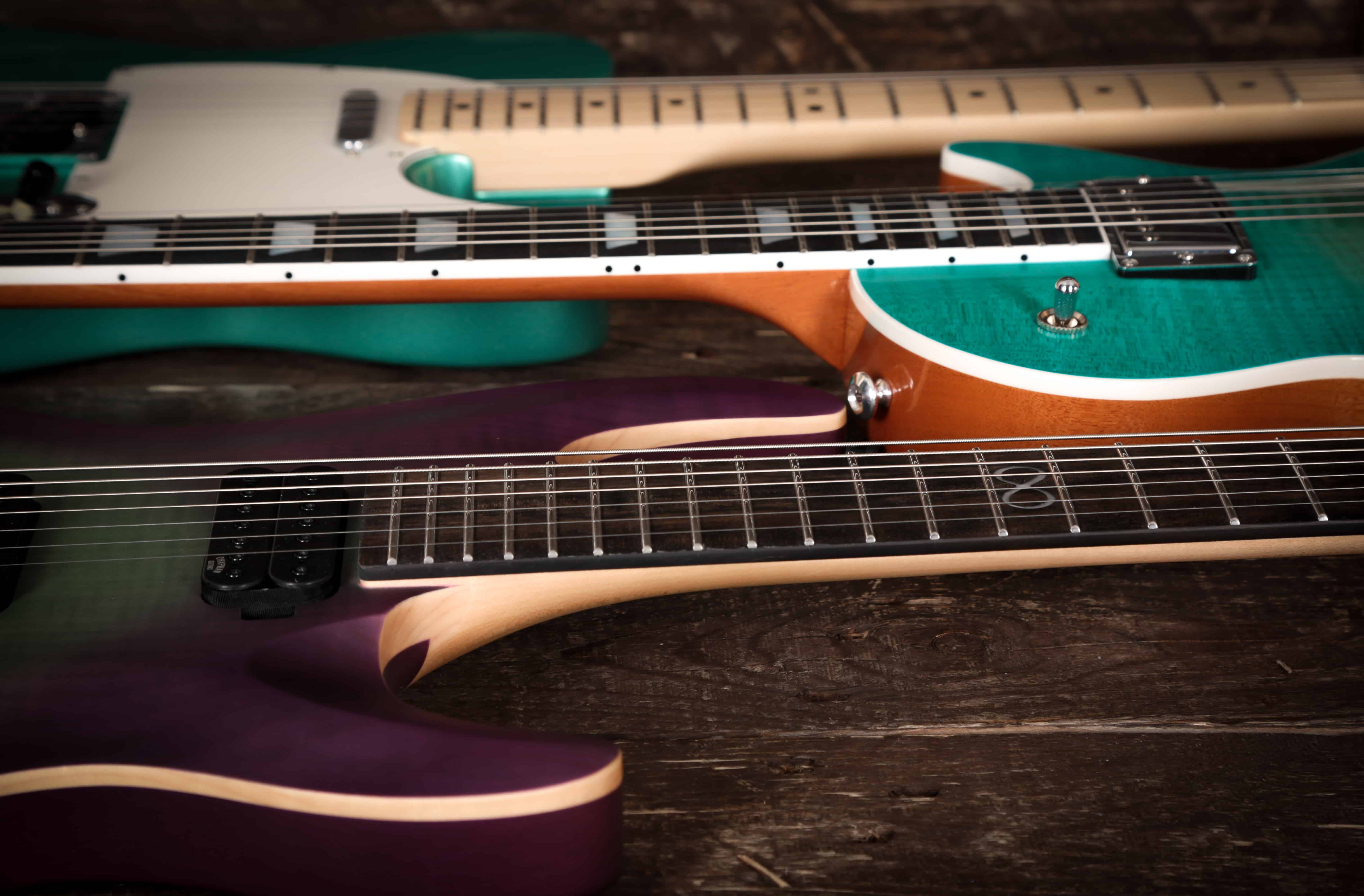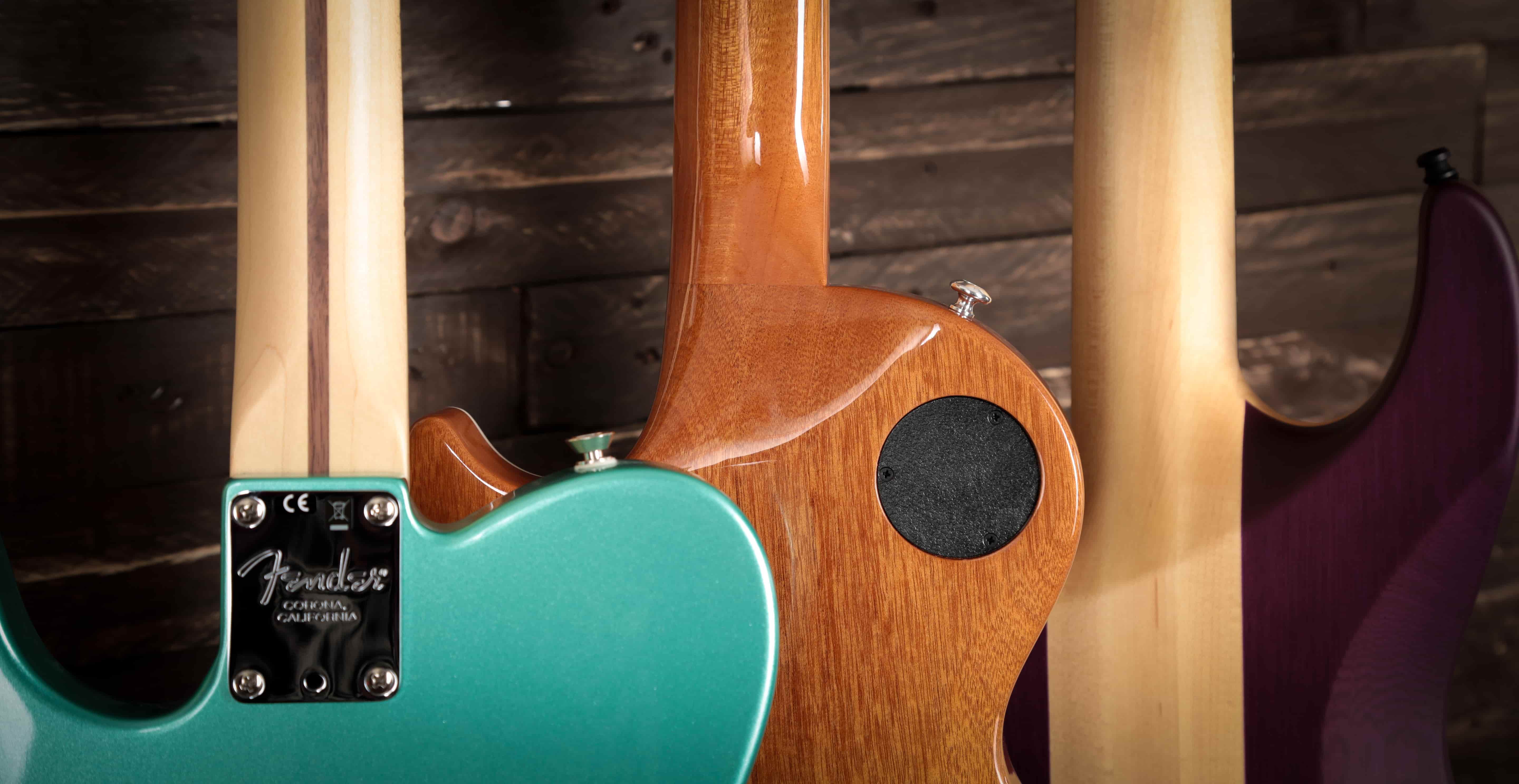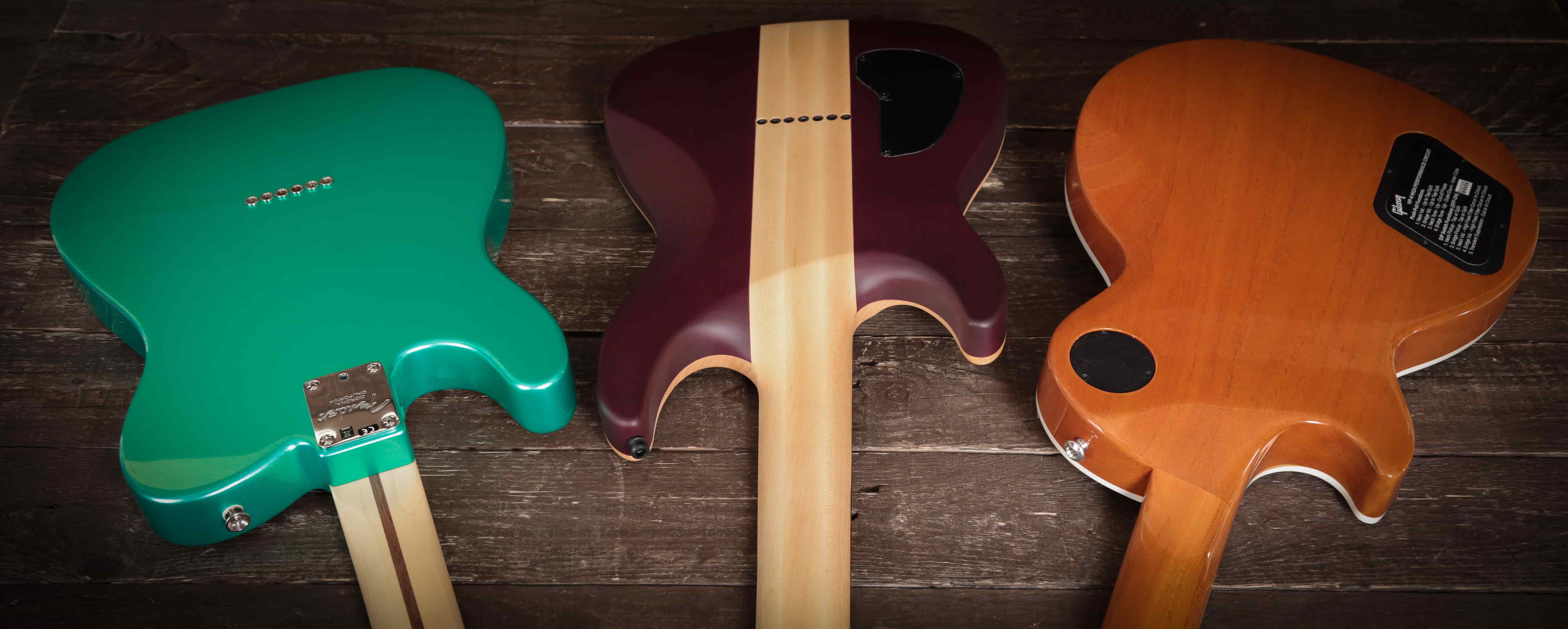- What Is a Bolt-On Neck Guitar?
- Bolt-On Neck Guitars
- Set Neck Guitars
- Neck-Through Guitars
- Final Thoughts: Which Neck Type Should You Choose?
There’s an age-old debate that says the type of electric guitar neck construction you choose will greatly influence its tone, resonance, and sustain.
We’ll explore how these neck joint types differ in feel and sound, and whether it even matters to help you make the best choice.
What Is a Bolt-On Neck Guitar?
Generally speaking, bolt-on neck guitars are thought of as more affordable, easier to manufacture, and simpler to repair. On the other hand, set-neck guitars are believed to have much more sustain but take longer to build due to the glue curing time in the dovetail joint between neck and body.
Then you’ve got neck-through guitars (often spelled “neck-thru”), which are practically all neck. As in, the neck continues all the way through the body as a single piece of wood, with two wings attached to form the rest of the guitar. A Gibson Firebird is a famous example, with the pickups mounted directly onto the piece of wood that runs through the body. Neck-through construction has also been hailed as one of the best when it comes to maximising sustain.
Each camp has its devotees, and some players don’t care too much about the argument. Many are happy to play all types of guitars and enjoy them for what they are. Here, we’ll highlight the pros and cons of bolt-on, set-neck, and neck-through guitars to help you choose the one that fits your style, or convince you that you can have one of each!

Bolt-On Neck Guitars
As the name suggests, ‘bolt-on’ means that the neck of the guitar is attached to the body by bolts or screws, rather than being glued or otherwise integrated into the body’s construction.
Bolt-on neck guitars are known for producing a snappier, brighter, and twangier tone compared to other types. This tonal character comes from how resonance transfers between the neck and body. That slight mechanical gap from the screw joint can form a barrier, slightly reducing sustain versus glued-in or continuous necks.
Bolt-on construction is common in many Fender guitars, like Stratocasters and Telecasters, as well as similar S-type and T-type models from the likes of G&L, Ibanez and others. Many brands use bolt-on necks due to their ease of manufacturing, as well as their tonal qualities. It’s much simpler to build bodies and necks separately and then use a bolt-on construction to put them together.
Pros of Bolt-On Necks
- Cost-effective and easy to repair or replace if needed.
- The twangy, snappy tone – some people simply prefer the general feel and response.
- Bolt-on constructions often use Maple necks, a dense wood that offers strong neck stability and resists warping or twisting.
Cons of Bolt-On Necks
- Sometimes seen as “cheaper” due to the construction method.
- Very slight loss of resonance and sustain compared to set-neck and neck-through models, due to the gap between neck and body.

Set Neck Guitars
Set necks are glued into the guitar body via a dovetail joint. A luthier will typically take a slab of Mahogany, carve a dovetail into the body and then slot the neck together, joining it with strong wood glue. This means that there is both a strong mechanical join and an adhesive join, such that when the glue sets, a permanent seamless bond is formed.
This construction is a hallmark of Gibson Les Paul guitars and other Gibson Custom Shop models, as well as PRS guitars like the Custom 24. Both brands are famous for using this neck construction and are proud ambassadors of the design.
The tonal transfer between neck and body is better in a set-neck than a bolt-on, resulting in a warmer and fuller sound. Though whether this is an improvement is subjective as some people prefer the ‘snap’ of a bolt-on. Set necks transfer the energy from your guitar strings and blur it in a way that fattens the body of a note and results in greater resonance and sustain.
Pros of Set Neck Guitars
- Great resonance.
- Produces a fat, smooth tone ideal for rock, blues, and jazz.
- Improved sustain due to the seamless neck-to-body coupling.
Cons of Set Neck Guitars
- Difficult to repair or reset; neck replacement is practically impossible.
- Less flexible if you want to change the neck profile or scale length later.

Neck-Through Guitars
Neck-through (or neck-thru) guitars feature a continuous piece of wood that forms both the neck and the central core of the body. This section is then used to mount the bridge, saddles and pickups for the best possible sustain, as the vibrations from the strings resonate through one uninterrupted piece of wood.
The sides or ‘wings’ of the body are then glued onto the neck core, using a laminate construction process. This middle neck-through laminate gives guitar makers the opportunity to bind different wood types together. This has been used to great effect to offer stunning neck stability, by companies like Ibanez and Schecter. You can get 3-piece, 5-piece, 7-piece and more!
Because neck-thru guitars are often made up of different types of wood, the neck will be less susceptible to conditions that might cause warp and twist. It’s almost like the woods counteract each other for more stability. They’re often favoured by shredders for their strength in maintaining a low action without the wood moving much.
Pros of Neck-Through Guitars
- Best possible sustain and resonance due to a single, continuous wood core that transfers the string vibrations directly to your pickups.
- Highly stable neck that maintains low action and resists warping.
Cons of Neck-Through Guitars
- Some argue that laminated wood sections don’t resonate as purely as single-piece wood.
- Difficult (if not impossible) to repair the neck without affecting the entire guitar.
- The breaks in the wood grain between pieces in the wings may cause slight tone loss.
Final Thoughts: Which Neck Type Should You Choose?
As you may have guessed, the best choice really comes down to personal preference and the kind of tone and feel you want from your electric guitar. If you can, it’s worth having a few different guitars to cover a wider tonal spectrum.
My favourite guitar is a PRS Custom 24 with a set Mahogany neck, but I also love my small collection of Telecasters for their unbeatable twang and attack. At the end of the day, it really is just down to you and what you prefer, there is no ‘right’ answer!
Now hopefully you have a better idea of what each type of neck construction is, and which one(s) might be right for you.
If you enjoyed the article then click here to read more of our Labs articles!!



Responses & Questions